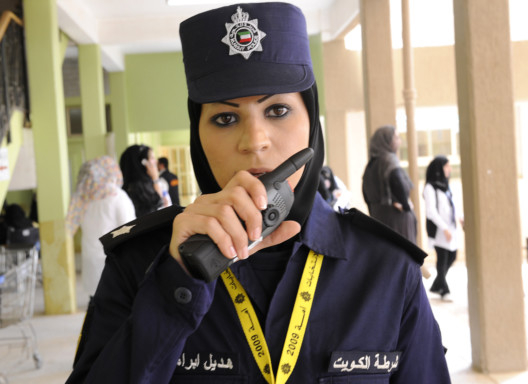
Manama: Noof looked up with pride as she took part in the parade under the mild sun enveloping Kuwait.
As one of the fresh military graduates, the young Kuwaiti woman felt that her childhood dream was coming true and that after several years of sacrifices, she was able to don the uniform that had been an integral part of her life.
Her dream was rendered possible thanks to the long-awaited decision to allow Kuwaiti women to join the security forces and contribute to the service of their country.
Allowing women to become servicewomen was, in fact, a breakthrough in the northern Arabian Gulf country where despite all the openness that characterises it, the society overall remained conservative and did not easily accept changes, especially to the status of women.
However, thanks to a robust determination from the country’s leaders and pro-women activists, the situation started to change and more women have gradually entered the security and work forces, steadily rising to positions of power and influence.
In March 2009, the country was dazzled by the impressive show of skills displayed by the first batch of 27 policewomen who graduated after five months of intensive learning courses and training sessions.
It was the beginning of a wide array of opportunities for women in uniform.
Seven years later, in March 2016, Lt. Col. Melody Mitchell, from the Office of Military Cooperation-Kuwait at the US embassy in Kuwait, was all praise for the increased participation of Kuwaiti women in the military.
“These women [VIP Protection Unit, Female Division] are all trailblazers, they are the role models for the young girls of Kuwait,” Mitchell said. “They play a critical role because terrorists in the Middle East have capitalised on cultural norms and use women to gain an advantage. We must do the same to match and overcome their efforts. Kuwait is wise to integrate women into their security apparatus,” she said, quoted by The Marines, the official website of the US Marine Corps.
In the civil service, the steady increase in the number of women in the public sector has allowed them to break social and occupational taboos about jobs, making inroads into the political and managerial sectors.
The latest official figures released in March this year indicate that of the 342,417 Kuwaitis who have jobs, women with 188,141 outnumber men at 154,276 in a clear indication of the vast progress they have made in the last few years.
This vastly outnumbers national women working in other Gulf countries. For example, Emirati women constitute only 23.9 per cent in the labour force, according to UAE Ministry of Economy 2014 figures.
The success of Kuwaiti women is the culmination of a long struggle that spanned more than four decades.
In 1971, and in a bold move, women’s rights activist Nooria Al Sadani, head of the Arab Women’s Day Committee, submitted a women’s political rights memorandum to the parliament. Lawmakers debated the issue during three sessions, but rejected it.
One year later, on December 11, MP Salem Al Marzooq presented a proposal to give educated Kuwaiti women the right to vote. Only 12 lawmakers supported his call.
Road to empowerment
The two failures somewhat dampened enthusiasm, but in February 1975, two lawmakers — Jasem Abdul Aziz Al Qatami and Rashid Al Farhan — presented a draft law to empower women politically. No action was taken and the situation remained stagnant until 1981 when Lawmaker Ahmad Al Fahd Al Takhim submitted a new bill that would give women the right to vote and run in elections. Other bills followed to empower women politically — by lawmaker Abdul Rahman Al Ghunaim in 1986; by lawmaker Hamad Al Jawaan in 1992; by MPs Ali Al Baghli, Abdul Mohsin Jamal, Abdullah Al Nibari and Jassem Saqr in 1994; and by MPs Salah Khorsheed and Abbas Al Khadhari in 1996.
In 1999, then Emir Shaikh Jaber Al Ahmad Al Sabah expressed full support for women’s political rights, including voting and running in parliamentary elections starting in 2003. The government drafted a law for the political empowerment of women. However, the parliament rejected the draft by a two-vote majority.
Activists refused to give in and persisted in their drive to secure the political empowerment of Kuwaiti women.
In 2002, the Constitutional Court threw out a case filed by two Kuwaiti women against the interior ministry for not allowing them to register their names in the electorate.
However, in May 2003, the government approved amendments to the municipal law allowing women to vote and run in municipal elections and to be appointed to municipal councils.
One year later, the government presented a bill to the parliament to amend the elections laws to allow women to run and vote.
The much-anticipated breakthrough occurred in May 2005 when 35 lawmakers voted to give women their full political rights, including running and voting in parliamentary elections. The motion was passed since only 23 lawmakers opposed it.
Women in Kuwait made history in June 2006 when Jinan Bushehri and Khalida Al Khedher became the first Kuwaiti women to contest in a municipal election.
In May 2008, it was the turn for 27 women from the five constituencies to make history by running in the parliamentary elections. None of them won, although Aseel Al Awadhi, Rola Dashti, Fatima Al Abdali and Dhikra Al Rasheedi obtained high scores.
However, exactly one year later, four women won in the parliamentary elections for the first time in Kuwait’s history. Maasooma Al Mubarak (the first woman minister in Kuwait), Salwa Al Jassar, Aseel Al Awadhi and Rola Dashti were hailed as the trailblazing architects.










